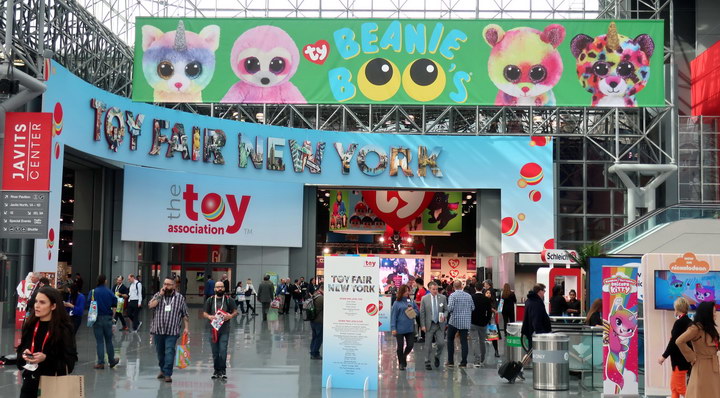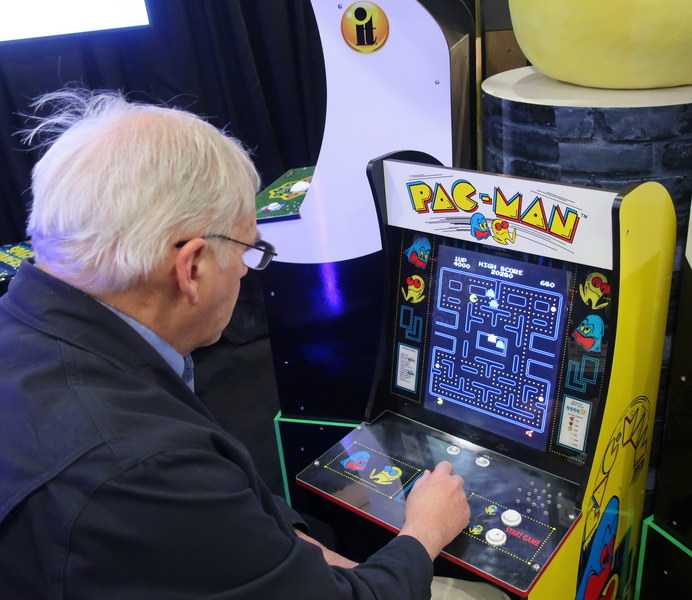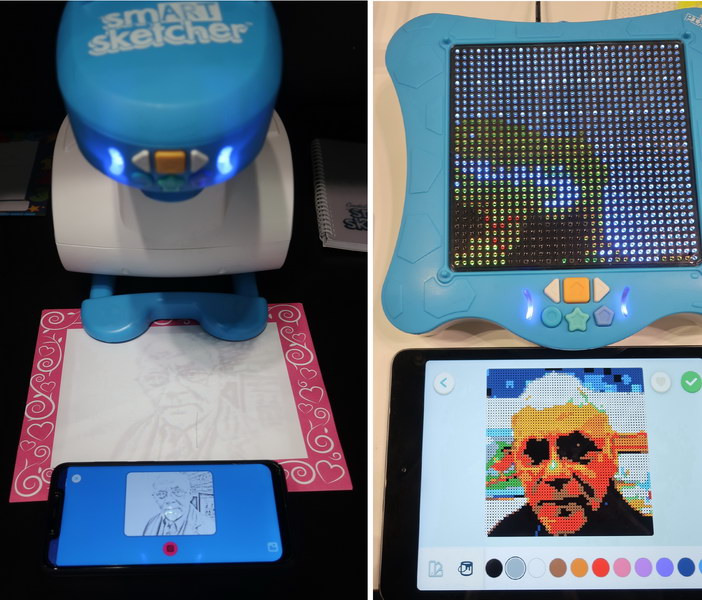On February 17th I went to the North American International Toy Fair in New York to see the latest in toy technology. The vast majority of toys at the show were made with old fashioned toy technology – plush toys, wooden toys, board games, dolls, etc. It is a big show and there were enough technology-based toys to be of interest.

 Main Entrance to the Toy Fair (Credit: M. Brennesholtz)
Main Entrance to the Toy Fair (Credit: M. Brennesholtz)
In past Toy Fairs, ‘Technology’ was a toy category and had a special section on the show floor. Modern technology is now so ingrained in the toy business that it is no longer a separate category. For example, most doll makers make not only traditional dolls but technology-enabled dolls that can talk to the children playing with them. But doll makers don’t want to be in a technology section, they want to be in the area reserved for doll makers.
One of the two talks I went to at the Toy Fair was a presentation by the Toy Association, an industry group founded in 1916 and host of the Toy Fair, on toy trends they have observed over the past year. One of the trends they discussed they called ‘Throwback Toys,’ about which they said:
“2019 will usher in big anniversaries for some of the entertainment world’s most beloved characters and movies, as well as iconic toys and games that will ignite a wave of nostalgia for parents and grandparents back to their childhood. Parents are looking to share toys and characters that played a big part of their childhoods with their kids and this will include classic low-tech playthings.”
High-tech playthings, too. The 2019 version of Mr. Potato Head now moves his lips while he talks to you. Toy makers are not reluctant to update 20th century toys with 21st century technology.
New Wave Toys showed it’s line of replica arcade video games. (Credit: M. Brennesholtz)
One category of ‘Throwback Toys’ that I saw at several different vendors at the show were modern replicas of arcade video game systems from the 70s and 80s. For example, New Wave Toys was showing its line of 1/6 scale arcade games, as shown in the photo. The man in the photo playing Dragon’s Lair, originally released by Cinematronics for the arcades in 1983, isn’t a man at all, he is a 10” doll with a Mohawk haircut playing the New Wave replica of the game.
The change machine doesn’t give change. Instead it is a USB power supply that will power up to 10 of the games or recharge your phone. The games are all fully functional and run the original software, licensed by New Wave. The representative told me the company has developed special processors that will run the original code. This is done for two reasons. First, the original code gives players the original “look and feel” of the arcade game. Second, according to the New Wave representative I talked to, the original object code is much harder for hackers to reuse because it runs on obsolete processors. If the original source code were recompiled for a modern processor, it would be much easier to steal and produce unlicensed versions of the games. He added that this wasn’t absolute protection against hacking but it helped.
The displays in these replicas were full color, full motion LCD panels about 2.3” diagonal with resolution of about 800 x 480. The rep wasn’t completely sure of the details and the different models had LCDs designed to match the aspect ratio of the original arcade game. This is something I also found at the National Retail Federation Big Show – the representatives on the floor knew little about the displays in the products they were selling.
The New Wave rep told me that the resolution of these small LCDs was in fact higher than the resolution of the original and much larger CRTs used in the arcade games in the 70s and 80s. The highest resolution of the original games was 480i and many games had lower resolution due to the limited speed of the game processors used. He said this was another reason to use a custom special processor in the modern replicas, to scale the output from the original game software to the new, higher LCD resolution and make it still look authentic.
The New Wave rep told me their main market was the collector market, along with people who wanted to actually play the arcade game. Most of their customers, in fact, had one foot in each of these camps. The company does its design and prototype work in California and, not surprisingly, its mass production in Shenzhen, China. Of the eight different models shown at the toy fair, three are in mass production and are available now at a MSRP of $120 while the other five plus the USB Change Machine are in various stages of the prototype process.
 Meko’s Matt Brennesholtz playing a ¾ scale Pac-Man Arcade game replica from Arcade1up (Credit: M. Brennesholtz)
Meko’s Matt Brennesholtz playing a ¾ scale Pac-Man Arcade game replica from Arcade1up (Credit: M. Brennesholtz)
New Wave wasn’t the only toy company selling retro video games. Arcade1Up, a division of Tastemakers LLC, makes a line of ¾ scale arcade machines, as shown in the photo. This series is newly introduced and won the 2019 Toy Fair Toy of the Year (TOTY) award in the Tech Toy category. These units are 45.8” (115cm) tall and are designed to be played by a person (e.g. me) seated on a stool. There is also a 13.5” (34cm) riser available with graphics matching the game for people who prefer standing up while playing. These consoles use 17” full color LCD screens.
The Arcade1Up rep explained that the company could not use the original CRTs for several reasons. First, CRTs simply are not available, as anyone reading this column is likely to know. Second, they would be too heavy and large for the ¾ size replica of the game. In addition, they have safety issues the company would not want to deal with. These units, which retail for $299, are primarily sold to people who want to play the game. In particular, matching the Toy Associations ‘Throwback Toys’ trend, they are sold to the parents, not the children, even when the parents pretend they are buying them for the kids. This matches the toy industry in general, especially for expensive toys like this. The toy must appeal to the child with the realization that it is not the child buying it, but an adult.
Arcade1Up introduced six of these ¾ scale units in 2018 and has five more for 2019. In addition, it has introduced for 2019 two other lines of arcade game systems, counter top versions they call ‘Counter Cade’ and miniature versions similar to the ones from New Wave Toys. These smaller versions are also, of course, playable.
 Left: Flycatcher’s SmART Sketch projector, with the author’s image on the smartphone and projected by the system onto blank paper. Right: Author’s image on a tablet and posterized to match available bead colors with one quadrant of the image shown on the SmART Pixelator display. (Credit: M. Brennesholtz)
Left: Flycatcher’s SmART Sketch projector, with the author’s image on the smartphone and projected by the system onto blank paper. Right: Author’s image on a tablet and posterized to match available bead colors with one quadrant of the image shown on the SmART Pixelator display. (Credit: M. Brennesholtz)
Flycatcher Inc. was at the Toy Fair with two display-centric toys. First was their SmART Sketcher, a miniature low resolution (140 x 128? The rep wasn’t sure) projector that projected an outline image on a white piece of paper for a child to trace and then color. The image could be one of the 50 built-in images, other images supplied by Flycatcher on cards, or an image taken with a smartphone, processed by the Flycatcher app into a line drawing with resolution to match the projector and then projected for copying and coloring. This projector had previously been shown at Toy Fair 2018.
Flycatcher was also showing a new toy called SmART Pixelator. This unit was essentially a 32 x 32 direct view full color LED array that would sit on a table top facing up. The child would then place beads, pegs or sequins at each pixel to copy the image. The beads could be fused into a continuous array with an ordinary hot iron for preservation of the bead image and removal from the display but the pegs and sequins could not. They required removing the clear substrate as well. When you bought extra pegs or sequins, you got extra substrates with them, exploiting the old “razor and razor blade” business model.
Like the SmART Sketcher, you could use either Flycatcher-supplied images or ones acquired by a smartphone. The smartphone image was processed by the app to both reduce the image resolution and posterize the colors to match the available beads. The resolution could be either 32 x 32 or 64 x 64. The higher resolution version required the image to be assembled in quadrants and final assembly of the quadrants was done external to the base display unit.
Besides the Toy Trends briefing, I went to the Play Innovation panel session where they discussed the integration of artificial intelligence (AI), robotics, virtual reality (VR), and augmented reality (AR) into toys. While there was a certain amount of robotics on the show floor, I saw virtually no AI, AR or VR there this year, unlike previous years. One thing the panelists agreed on was the importance of making these technologies invisible to the child playing with the toy. This trend was helped by the shrinking of technology, making it much easier to hide even in small toys. So maybe AI, AR and VR was there at the Toy Fair, after all, and I just didn’t recognize it.
AI was actually the main topic of discussion at this panel, not robotics, AR or VR. One example a panelist gave was using Amazon’s Alexa to provide the voice recognition and other AI features needed in toys. For example, many children have an ‘imaginary friend’ that they talk to. With Alexa, the imaginary friend could talk back and the child wouldn’t need to pretend to hear the friend. In the process, of course, your child will have shared all his most secret thoughts with Amazon, perhaps not something most parents would wish their children to do. –Matthew Brennesholtz

